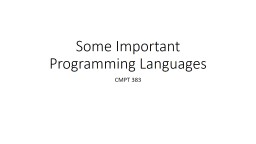

CMPT 383 Fortran 1957 Fortran Formula Translator Design by John Backus et al from IBM Designed to be easier to use than machine language 1 st version for the IBM 704 Extremely popular with scientists and engineers ID: 1001380
Download Presentation The PPT/PDF document "Some Important Programming Languages" is the property of its rightful owner. Permission is granted to download and print the materials on this web site for personal, non-commercial use only, and to display it on your personal computer provided you do not modify the materials and that you retain all copyright notices contained in the materials. By downloading content from our website, you accept the terms of this agreement.
1. Some Important Programming LanguagesCMPT 383
2. Fortran (1957)Fortran = Formula TranslatorDesign by John Backus et al from IBMDesigned to be easier to use than machine language1st version for the IBM 704Extremely popular with scientists and engineersStill in use today
3. C AREA OF A TRIANGLE WITH A STANDARD SQUARE ROOT FUNCTIONC INPUT - TAPE READER UNIT 5, INTEGER INPUTC OUTPUT - LINE PRINTER UNIT 6, REAL OUTPUTC INPUT ERROR DISPLAY ERROR OUTPUT CODE 1 IN JOB CONTROL LISTING READ INPUT TAPE 5, 501, IA, IB, IC 501 FORMAT (3I5)C IA, IB, AND IC MAY NOT BE NEGATIVE OR ZEROC FURTHERMORE, THE SUM OF TWO SIDES OF A TRIANGLEC MUST BE GREATER THAN THE THIRD SIDE, SO WE CHECK FOR THAT, TOO IF (IA) 777, 777, 701 701 IF (IB) 777, 777, 702 702 IF (IC) 777, 777, 703 703 IF (IA+IB-IC) 777, 777, 704 704 IF (IA+IC-IB) 777, 777, 705 705 IF (IB+IC-IA) 777, 777, 799 777 STOP 1C USING HERON'S FORMULA WE CALCULATE THEC AREA OF THE TRIANGLE 799 S = FLOATF (IA + IB + IC) / 2.0 AREA = SQRTF( S * (S - FLOATF(IA)) * (S - FLOATF(IB)) * + (S - FLOATF(IC))) WRITE OUTPUT TAPE 6, 601, IA, IB, IC, AREA 601 FORMAT (4H A= ,I5,5H B= ,I5,5H C= ,I5,8H AREA= ,F10.2, + 13H SQUARE UNITS) STOP ENDPROGRAM Fibonacci IMPLICIT NONE INTEGER :: FIRST, SECOND, TEMP, IX FIRST = 0 SECOND = 1 WRITE (*,*) FIRST WRITE (*,*) SECOND DO IX = 1, 45, 1 TEMP = FIRST + SECOND FIRST = SECOND SECOND = TEMP WRITE (*,*) TEMP END DOEND PROGRAM FibonacciMore Modern Fortran
4. LISP (1958)LISP = List ProcessingDesigned by John McCarthy and his studentsDesigned for symbolic processing (e.g. calculating symbolic derivatives) and AIExtremely simple core languagePioneered many programming ideasMany dialects over the years (defun factorial (n) (if (= n 0) 1 (* n (factorial (- n 1)))))
5. COBOL (1959) COBOL = Common Business-Oriented LanguageAssociated with Rear Admiral Grace Hopper, who designed a predecessor called Flow-maticSpecifically for businessExtremely popular
6. IDENTIFICATION DIVISION. PROGRAM-ID. "Fibonacci". ENVIRONMENT DIVISION. DATA DIVISION. WORKING-STORAGE SECTION. 01 ix BINARY-C-LONG VALUE 0. 01 first-number BINARY-C-LONG VALUE 0. 01 second-number BINARY-C-LONG VALUE 1. 01 temp-number BINARY-C-LONG VALUE 1. 01 display-number PIC Z(19)9. PROCEDURE DIVISION.* This is the start of the program START-PROGRAM. MOVE first-number TO display-number. DISPLAY display-number. MOVE second-number TO display-number. DISPLAY display-number. PERFORM VARYING ix FROM 1 BY 1 UNTIL ix = 90 ADD first-number TO second-number GIVING temp-number MOVE second-number TO first-number MOVE temp-number TO second-number MOVE temp-number TO display-number DISPLAY display-number END-PERFORM. STOP RUN.
7. Algol Languages (1960s)Algol = Algorithmic LanguageInfluential set of languages designed by a group of computer scientists (including Backus and McCarthy)Pioneered many now-standard language features (and more)No longer popular in practice, but still very influentialprocedure Absmax(a) Size:(n, m) Result:(y) Subscripts:(i, k); value n, m; array a; integer n, m, i, k; real y;comment The absolute greatest element of the matrix a, of size n by m is transferred to y, and the subscripts of this element to i and k;begin integer p, q; y := 0; i := k := 1; for p := 1 step 1 until n do for q := 1 step 1 until m do if abs(a[p, q]) > y then begin y := abs(a[p, q]); i := p; k := q endend AbsmaxAlgol 60 Example
8. SmallTalk (1970s)Developed by Alan Kay and his group at Xerox ParcHelped popularize OOP, especially in North AmericaNot the first object-oriented programming (OOP) language (that was SIMULA, from the 1960s)factorial "Answer the factorial of the receiver." self = 0 ifTrue: [^ 1]. self > 0 ifTrue: [^ self * (self - 1) factorial]. self error: 'Not valid for negative integers'Squeak Code Example
9. Prolog (1972)Prolog = Programming LogicDeclarative, logic-based, constraint-orientedDeveloped by Alain Colmerauer (although many others helped develop the underlying ideas)Certain complex problems have beautifully simple Prolog solutionsCertain easy problems have ugly and complex Prolog solutionspartition([], _, [], []).partition([X|Xs], Pivot, Smalls, Bigs) :- ( X @< Pivot -> Smalls = [X|Rest], partition(Xs, Pivot, Rest, Bigs) ; Bigs = [X|Rest], partition(Xs, Pivot, Smalls, Rest) ). quicksort([]) --> [].quicksort([X|Xs]) --> { partition(Xs, X, Smaller, Bigger) }, quicksort(Smaller), [X], quicksort(Bigger).Quicksort in Prolog